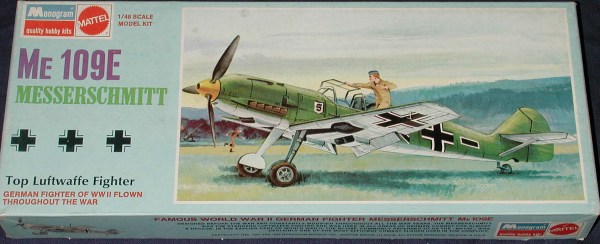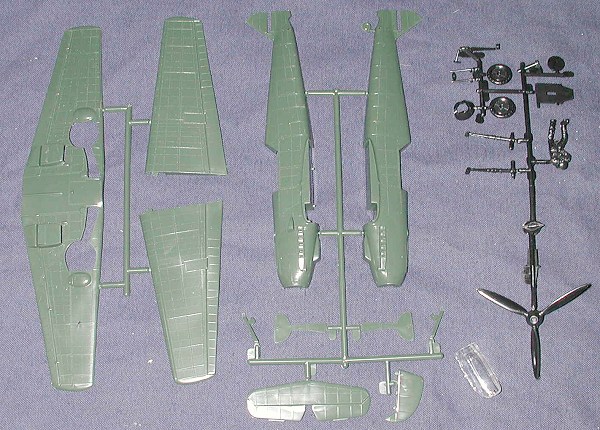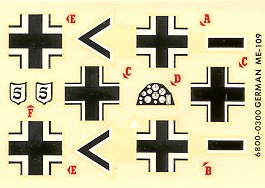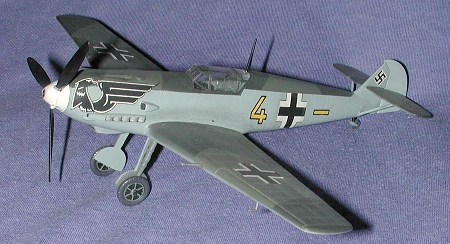
|
KIT: |
Monogram 1/48 Me-109E |
|
KIT # |
6800 |
|
PRICE: |
A buck in 1968 |
|
DECALS: |
One option |
|
REVIEWER: |
Scott Van Aken |
|
NOTES: |
1968 boxing, first molded in 1962 |

|
HISTORY |
|
THE KIT |

Though no longer produced (the last time I bought one was in the late 1980s), the Monogram Bf-109E was yards ahead of its nearest competitor (Aurora) in terms of detail during the 1960s. Unlike the Aurora kit, this one actually looked like a Bf-109E and upon examination, it seems to be the 109E-3 with the wing cannon. It also has to be one of the simplest of the 'quarter scale' kits as the only operating feature (other than a spinning prop) is retractable landing gear.
The interior consists of a rear bulkhead with armor plate and a pilot to fit into it. No floor, sidewalls, seat, control stick, instrument panel or rudder pedals. The detailing is the usual fine rivets that were so common with kits of the sixties and early 70's. The landing gear are trapped between the upper and lower wing. How well you trap it will decide how easily the gear retract. They are shown in the drawing at the proper angle, but on the last one of these I built, they stuck straight down. You can install the prop after the fuselage halves are together, with is a nice touch. It has a single piece canopy with very thick plastic, but since there is no real interior, this isn't a problem. Naturally, one has rolling wheels by heating the end of the axles with a hot knife once the wheels are in place.
 Instructions
are just what was the norm for the 60s and Monogram. There are lots of
photographs and a written construction sequence. Painting info is at the
end of the instructions along with decal application. The markings are
for an RLM 70/71/65 splinter painted plane with low demarcation lines,
but none of that is mentioned in the instructions. They simply state it
is dark green over light blue with some having mottled fuselages with the
mottling in g
Instructions
are just what was the norm for the 60s and Monogram. There are lots of
photographs and a written construction sequence. Painting info is at the
end of the instructions along with decal application. The markings are
for an RLM 70/71/65 splinter painted plane with low demarcation lines,
but none of that is mentioned in the instructions. They simply state it
is dark green over light blue with some having mottled fuselages with the
mottling in g rey. We know now that this is incorrect, but back then it
wasn't really important. Decals are for a generic JG 26 aircraft and it
includes an instrument panel decal to be placed where the instrument
panel should be on this plane. Despite being 35 years old, my decals are
in super condition and only slightly yellowed.
rey. We know now that this is incorrect, but back then it
wasn't really important. Decals are for a generic JG 26 aircraft and it
includes an instrument panel decal to be placed where the instrument
panel should be on this plane. Despite being 35 years old, my decals are
in super condition and only slightly yellowed.
As you can see in the image to the left, my old Monogram 109, complete with oversize nose decals from a long-forgotten decal sheet, is still around and still has the landing gear at laughable angles!
|
CONCLUSIONS |
Naturally, a kit like this would only appeal to the collector as Tamiya and Hasegawa have pretty well made it into a toy by comparison with the quality products they have released. Still, if you have a youngster who is interested in plastic models, it would be perfect for them. I know it was for me!
If you would like your product reviewed fairly and quickly by a site that has nearly 250,000 visitors a month, please contact me or see other details in the Note to Contributors.